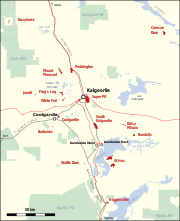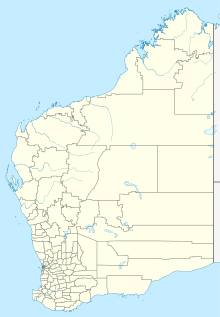 Satellite image of
Lake Lefroy, with the St Ives Gold Mine near the centre of the image, south of the lake | |
| Location | |
|---|---|
| Location | Kambalda |
| State | Western Australia |
| Country | Australia |
| Coordinates | 31°19′14″S 121°44′25″E / 31.32056°S 121.74028°E |
| Production | |
| Products | Gold |
| Production | 371,800 |
| Financial year | 2023 |
| Owner | |
| Company | Gold Fields Limited |
| Website |
www |
| Year of acquisition | November 2001 |
|
| |
The St Ives Gold Mine is a gold mine located 20 km south-east of Kambalda, Western Australia. It is owned by the South African mining company Gold Fields. [1]
As of 2022, it is one of four mines the company operates in Australia, the others being the Agnew Gold Mine, Granny Smith Gold Mine and the Gruyere Gold Mine. [2]
Ore is mined at St Ives in three underground and four open-pit operations. [3]
History

Gold mining in the area south of Lake Lefroy began as early as 1897 in small-scale operations but large-scale mining only began from 1920 onwards. In late 1919, prospector Pat Ives discovered gold further south from the original workings, with the gold mining district subsequently named after him. [4] [5]
A number of mines started operating in the area in the early 1920s, the largest of these being the Ives Reward Mine, which operated until 1926 and produced 7,115 ounces of gold throughout its operation. Including the Redhill Gold Mine at Kambalda, north of Lake Lefroy, the gold mining district produced 19,000 ounces of gold throughout this time. [4]
The Western Mining company, WMC, did some exploration in the area in 1937 but did not carry out any mining during this time, with the St Ives district seeing very little gold mining all up during the following decades. WMC returned to prospecting in the area in 1966, now in search of nickel. WMC subsequently developed the Kambalda Nickel Operations which, from 1974 onwards, also produced some gold from the nickel mine. A process plant for gold was eventually added at Kambalda in 1980. By mid-1980, gold exploration south of the lake, at the original St Ives mining location Victory, achieved good results. Consequently, a Carbon in pulp plant was constructed at Kambalda and commenced operations on 23 October 1981 to process ore from St Ives which was officially named the Kambalda Gold Operations. [4]
The annual throughput of the process plant at Kambalda was expanded to 750,000 tonnes by 1982, with the gold produced at the mine offsetting WMC's declining profits from nickel caused by a drop in price for the commodity. The increasing size of the gold operation and the difficulty and cost of transporting the ore across the lake to Kambalda led WMC to the decision to construct a separate gold mining plant at St Ives, which was commissioned in May 1988 and eventually expanded to an annual throughput of three million tonnes. [4]
In July 1992, the Kambalda Gold Operations were renamed to St Ives Gold Mines and, by December 1982, the WMC operation at St Ives had produced one million ounces of gold. A large number of ore bodies at St Ives have been named after ships present at the 1805 Battle of Trafalgar, with 13 orebodies named on the eastern side of the main road after British ships and four on the western side after Spanish and French ships. [4]
The mine was purchased by Goldfields from WMC in late 2001. [6] [7] The combined price for the two Australian operations Goldfields purchased, St Ives and the Agnew Gold Mine, was US$180 million in cash and US$52 million in Gold Fields shares.
St Ives, in 2009, employed 249 permanent staff and 926 contractors. [3]
Production
Annual production of the mine: [6] [8] [3] [9] [10] [11] [12] [13] [14] [15]
| Year | Production | Grade | Cost per ounce |
|---|---|---|---|
| 2000 | 408,155 ounces | 3.92 g/t | |
| 2001 | 455,183 ounces | 3.01 g/t | |
| 2002 | 542,200 ounces | 3.03 g/t | A$ 295 |
| 2002–03 | 513,000 ounces | 2.9 g/t | A$323 |
| 2003–04 | 543,000 ounces | 2.5 g/t | A$416 |
| 2004–05 | 527,000 ounces | 2.6 g/t | A$447 |
| 2005–06 | 496,000 ounces | 2.3 g/t | A$453 |
| 2006–07 | 487,000 ounces | 2.2 g/t | A$540 |
| 2007–08 | 418,000 ounces | 1.8 g/t | A$649 |
| 2008–09 | 428,300 ounces | 1.8 g/t | A$805 |
| 2010 | |||
| 2011 | |||
| 2012 | |||
| 2013 | |||
| 2014 | 2.6 g/t | ||
| 2015 | 372,000 ounces | 3.2 g/t | US$969 |
| 2016 | 363,000 ounces | 3 g/t | US$949 |
| 2017 | 364,000 ounces | 2.96 g/t | US$916 |
| 2018 | 367,000 ounces | 2.88 g/t | US$902 |
| 2019 | 371,000 ounces | A$1,385 | |
| 2020 | 385,000 ounces | A$1,266 | |
| 2021 | 393,000 ounces | 2.99 g/t | A$1,385 |
| 2022 | 377,000 ounces | 3.04 g/t | A$1,594 |
| 2023 | 371,800 ounces | 2.83 g/t | A$1,958 |
References
- ^ St Ives, Australia, Gold AME Group website, retrieved 2015-02-17
- ^ "Australian Locations". Gold Fields. Retrieved 24 February 2021.
- ^ a b c Review of International Operations - St Ives Gold Mine Goldfields website, retrieved 2009-08-13
- ^ a b c d e Gilbert M. Ralph (1 May 1995). Group Historical Information: St Ives Gold Mines (Report). WMC Resources. Retrieved 18 March 2023 – via National Library of Australia.
- ^ St Ives gold-mine Miningweekly.com, retrieved 2009-08-13
- ^ a b The Australian Mines Handbook: 2003-2004 Edition, page 124
- ^ News briefs Mining Engineering magazine, published 2001-11-01, retrieved 2009-08-09
- ^ Annual Report 2005 Gold Fields website, retrieved 2009-08-13
- ^ Quarterly report June 2009 Goldfields website, retrieved 2009-08-13
- ^ "2021 Integrated Annual Report" (PDF). Gold Fields Limited. p. 50. Retrieved 31 March 2022.
- ^ "2020 Integrated Annual Report" (PDF). Gold Fields Limited. p. 71. Retrieved 31 March 2022.
- ^ "St Ives Mine". Mining Data Solutions. Retrieved 31 March 2022.
- ^ "Agnew Mine". Mining Data Solutions. Retrieved 31 March 2022.
- ^ "Reviewed results For the year ended 31 December 2022" (PDF). Gold Fields Limited. Retrieved 1 March 2023.
- ^ "Reviewed results for the year ended 31 December 2023" (PDF). Gold Fields Limited. Retrieved 25 February 2024.
Bibliography
- Louthean, Ross (ed.). The Australian Mines Handbook: 2003-2004 Edition. Louthean Media Pty Ltd.
External links
- Official website
- MINEDEX website: Kambalda - St Ives Database of the Department of Mines, Industry Regulation and Safety
